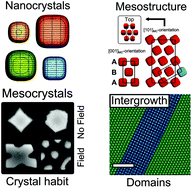Erik Wetterskog*, Alice Klapper, Sabrina Disch, Elisabeth Josten, Raphaël P. Hermann, Ulrich Rücker, Thomas Brückel, Lennart Bergström and German Salazar-Alvarez*
Nanoscale (2016)
DOI: 10.1039/C6NR03776C
Abstract:
A precise control over the meso- and microstructure of ordered and aligned nanoparticle assemblies, i.e., mesocrystals, is essential in the quest of exploiting collective material properties for potential applications. In this work, we produce evaporation-induced self-assembled mesocrystals with different mesostructures and crystal habits based on iron oxide nanocubes by varying the nanocube size and shape, and by applying magnetic fields. A full 3D characterization of the mesocrystals was performed using image analysis, high-resolution scanning electron microscopy and Grazing Incidence Small Angle X-ray Scattering (GISAXS). This enabled structural determination of e.g. multi-domain mesocrystals with complex crystal habits, and the quantification of interparticle distances with sub-nm precision. Mesocrystals of small nanocubes (l = 8.6 – 12.6 nm) are isostructural with a body centred tetragonal (bct) lattice whereas assembly of the largest nanocubes in this study (l = 13.6 nm) additionally form a simple cubic (sc) lattice. The mesocrystal habit can be tuned from a square, hexagonal to star-like and pillar shapes depending on the particle size, shape, and the strength of the applied magnetic field. Finally, we outline a qualitative phase diagram of the evaporation-induced self-assembled superparamagnetic iron oxide nanocube mesocrystals based on nanocube edge length and magnetic field strength.
2016-07-09
3D visualization of iron oxidation state in FeO/Fe3O4 core-shell nanocubes from electron energy loss tomography
Pau Torruella, Raul Arenal, Francisco de la Peña*, Zineb Saghi, Lluís Yedra, Alberto Eljarrat, Lluis Lopez-Conesa, Marta Estrader*, Alberto López-Ortega, German Salazar-Alvarez, Josep Nogués Sanmiquel, Caterina Ducati, Paul A. Midgley, Francesca Peiró, and Sonia Estrade*
Nano Letters, 16 (2016) 5068-5073
DOI: 10.1021/acs.nanolett.6b01922
Abstract:
The physicochemical properties used in numerous advanced nanostructured devices are directly controlled by the oxidation states of their constituents. In this work we combine electron energy-loss spectroscopy, blind source separation, and computed tomography to reconstruct in three dimensions the distribution of Fe2+ and Fe3+ ions in a FeO/Fe3O4 core/shell cube-shaped nanoparticle with nanometric resolution. The results highlight the sharpness of the interface between both oxides and provide an average shell thickness, core volume, and average cube edge length measurements in agreement with the magnetic characterization of the sample.
Abstract:
The physicochemical properties used in numerous advanced nanostructured devices are directly controlled by the oxidation states of their constituents. In this work we combine electron energy-loss spectroscopy, blind source separation, and computed tomography to reconstruct in three dimensions the distribution of Fe2+ and Fe3+ ions in a FeO/Fe3O4 core/shell cube-shaped nanoparticle with nanometric resolution. The results highlight the sharpness of the interface between both oxides and provide an average shell thickness, core volume, and average cube edge length measurements in agreement with the magnetic characterization of the sample.
Subscribe to:
Posts (Atom)

